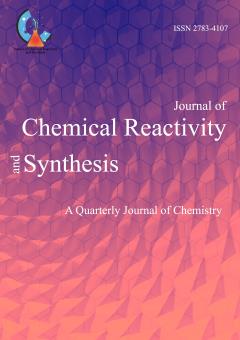Reactivity and Electronic Structure Alterations of Crizotinib in the Presence of Neurotoxic β-Amyloid Aggregates
الموضوعات :
Mohammad Reza Bozorgmehr
1
![]() ,
Malihe Sarvari Zare
2
,
Sharareh Mohseni
3
,
S. Ali Beyramabadi
4
,
Malihe Sarvari Zare
2
,
Sharareh Mohseni
3
,
S. Ali Beyramabadi
4
1 - Dept. of Chemistry, Faculty of ScienceMashhad branch, Islamic Azad University, Mashhad, Iran
2 - گروه شیمی، واحد مشهد، دانشگاه آزاد اسلامی، مشهد، ایران
3 - Department of Chemistry, Quchan Branch, Islamic Azad University, Quchan, Iran
4 - Department of Chemistry, Mashhad Branch, Islamic Azad University, Mashhad, Iran
الکلمات المفتاحية: Crizotinib, chemical reactivity, Alzheimer, Aggregation, Molecular dynamics,
ملخص المقالة :
Crizotinib, a known tyrosine kinase inhibitor in cancer treatment, is investigated here for its interactions with neurodegenerative disease-related biomolecules, specifically beta-amyloid (Aβ42) peptides. Using Density Functional Theory (DFT) with the B3LYP/6-31G(d,p) method, Crizotinib’s molecular structure was optimized to ensure stability. Molecular dynamics (MD) simulations were conducted with GROMACS, applying the CHARMM force field for peptides and GAFF for Crizotinib. The simulation involved solvating the system, neutralizing it, and running a 100-nanosecond production under physiological conditions. Electronic structure analysis through DFT provided insight into the Highest Occupied Molecular Orbital (HOMO) and Lowest Unoccupied Molecular Orbital (LUMO) distributions of Crizotinib both with and without Aβ42. The results revealed notable shifts in Crizotinib’s electronic properties upon interaction with Aβ42, indicating altered chemical reactivity and binding potential. Specifically, an expanded electron cloud suggested that non-covalent interactions, such as hydrogen bonding and π-π stacking, play a role in these changes. These findings propose that Crizotinib could influence Aβ42-related pathways, which are central to Alzheimer’s disease. The study emphasizes the value of computational tools in exploring drug interactions with neurotoxic peptides and suggests potential therapeutic relevance of Crizotinib in neurodegenerative disorders.
[1] Ou, S.-H.I. (2011) Drug design, development and therapy, 471.
[2] Lim, J.W., Kim, S.K., Choi, S.Y., Kim, D.H., Gadhe, C.G., Lee, H.N., Kim, H.-J., Kim, J., Cho, S.J. and Hwang, H. (2018) European Journal of Medicinal Chemistry, 157, 405.
[3] Tiwari, S., Atluri, V., Kaushik, A., Yndart, A. and Nair, M. (2019) International journal of nanomedicine, 5541.
[4] Song, C., Zhang, T. and Zhang, Y. (2022) Molecules, 27, 6751.
[5] Bharadwaj, P.R., Dubey, A.K., Masters, C.L., Martins, R.N. and Macreadie, I.G. (2009) Journal of cellular and molecular medicine, 13, 412.
[6] Fišar, Z. (2022) Biomolecules, 12, 1676.
[7] Tönnies, E. and Trushina, E. (2017) Journal of Alzheimer’s disease, 57, 1105.
[8] Ando, K., Küçükali, F., Doeraene, E., Nagaraj, S., Antonelli, E.M., Thazin Htut, M., Yilmaz, Z., Kosa, A.-C., Lopez-Guitierrez, L. and Quintanilla-Sánchez, C. (2024) Acta Neuropathologica, 147, 94.
[9] Tanizaki, J., Okamoto, I., Okamoto, K., Takezawa, K., Kuwata, K., Yamaguchi, H. and Nakagawa, K. (2011) Journal of Thoracic Oncology, 6, 1624.
[10] Cheong, S.L., Tiew, J.K., Fong, Y.H., Leong, H.W., Chan, Y.M., Chan, Z.L. and Kong, E.W.J. (2022) Pharmaceuticals, 15, 1560.
[11] Frisch, A. (2009) Wallingford, USA, 25p, 470.
[12] Berendsen, H.J., van der Spoel, D. and van Drunen, R. (1995) Computer physics communications, 91, 43.
[13] Brooks, B.R., Brooks III, C.L., Mackerell Jr, A.D., Nilsson, L., Petrella, R.J., Roux, B., Won, Y., Archontis, G., Bartels, C. and Boresch, S. (2009) Journal of computational chemistry, 30, 1545.
[14] Zoete, V., Cuendet, M.A., Grosdidier, A. and Michielin, O. (2011) Journal of computational chemistry, 32, 2359.
[15] Meza, J.C. (2010) Wiley Interdisciplinary Reviews: Computational Statistics, 2, 719.
[16] Lemak, A. and Balabaev, N. (1994) Molecular Simulation, 13, 177.
[17] Hess, B., Bekker, H., Berendsen, H.J. and Fraaije, J.G. (1997) Journal of computational chemistry, 18, 1463.


